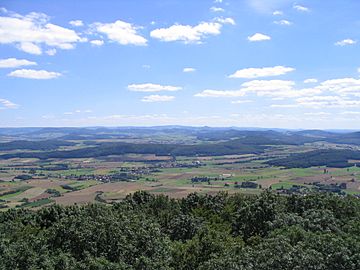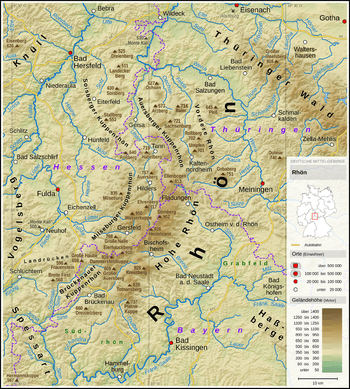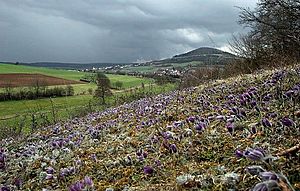Rhön Mountains facts for kids
Quick facts for kids Rhön Mountains |
|
|---|---|

View from the Soisberg looking south towards the Rhön
|
|
| Highest point | |
| Peak | Wasserkuppe |
| Elevation | 950 m above NN |
| Dimensions | |
| Length | 70 km (43 mi) |
| Area | 1,860 km2 (720 sq mi) |
| Geography | |
| Country | Germany |
| States/Provinces | Hesse, Bavaria and Thuringia |
| Range coordinates | 50°31′00″N 10°02′29″E / 50.516551°N 10.041391°E |
| Parent range | East Hessian Highlands |
| Geology | |
| Orogeny | Low mountains |
| Age of rock | 250 - 23 mya |
| Type of rock | Bunter sandstone, Muschelkalk, Keuper, Vulcanite |

The Rhön Mountains are a group of low mountains in central Germany, in the states Hesse, Bavaria and Thuringia. They are the product of ancient volcanic activity and are separated from the Vogelsberg Mountains by the Fulda River and its valley.
These mountains are a popular tourist attraction. Hikers come for the nearly 6,000 km (3,750 miles) of tracks through the picturesque scenery, and gliding has been done here since the early Twentieth century. Nowadays people come here to stay on a farm during holidays, too.
Since 1991, UNESCO has declared the Rhön a Biosphere Reserve.
-
Wasserkuppe, highest point of Rhön and Hesse
The highest mountains of the Rhön are:
- Wasserkuppe 950 m (3,110 ft), (Hessian Rhön)
- Kreuzberg (mountain) 928 m (3,040 ft) (Bavarian Rhön)
- Schwabenhimmel 926 m (3,040 ft) (Bavarian Rhön)
- Heidelstein 913 m (3,000 ft) (Bavarian Rhön)
- Milseburg 835 m (2,740 ft) (Hessian Rhön)
- Feuerberg 832 m (2,730 ft) (Bavarian Rhön)
- Ellenbogen 814 m (2,670 ft) (Thuringian Rhön)
Flora and fauna
As a result of its geography and geology the Rhön is an area with higher-than-average number of different habitats and species. But man, too, has generated valuable secondary habitats by creating a rich cultural landscape.
Plant life

Compared with other low mountain regions, the Rhön is particularly rich in plant varieties. Its natural vegetation would probably be dominated by beech woods with scattered groups of other trees, but today beech trees are very much in decline. A few of these ancient woods were identified as core elements of the Rhön biosphere reserve. The higher beech woods are a habitat for rare, sometimes isolated, species of plant such as the Alpine blue-sow-thistle, giant bellflower and annual honesty. The vegetation of the lower-lying beech woods has a mix of mountain and other varieties. In addition to common wildflowers like the martagon lily, lily of the valley, wild chervil and wild garlic, various orchids also flourish here including Cephalanthera orchids, the yellow coralroot, bird's-nest orchid, lady's slipper and lady orchid.
Only small areas of the Rhön landscape are essentially open: the raised bogs (Hochmoore), the rock outcrops and the stone runs. These habitats are home to highly specialised species. The raised bogs of the Long Rhön - the Red Moor (Rotes Moor) and the Black Moor (Schwarzes Moor) are floristically important links between the northern and Alpine raised bogs. Here, for example, can be found sundews, crowberry and cottongrass. Growing amongst the rocks of the volcanic mountains are rare species such as Cheddar pink, sweet william catchfly, oblong woodsia and fir clubmoss.
There are no naturally occurring coniferous forests in the Rhön, but notable species of wild flower such as the lady's slipper orchid, creeping lady's tresses and burning-bush are found in the forests of mixed pine.
The cultural landscape formed by mankind over the centuries also has a great variety of habitats and plants however, today, the extensive grassland areas are amongst the most threatened and heavily cultivated habitats. It is on the semi-arid grasslands and juniper heaths that the silver thistle, symbol of the Rhön region, grows, alongside gentians, pasque flowers and wood anemones, as well as orchids like the early purple, fragrant and fly orchids. Rarer flowers include the various bee orchids and the military, lady, burnt, green-winged, man, pyramidal, frog and lizard orchids. Along the southern fringes of the Rhön, on the so-called slopes of steppe heathland (Steppenheidenhängen) grow warmth-loving plants such as white rock-rose, erect clematis and honewort.
Amongst the most valuable habitats in the Rhön are the mountain meadows and fields of mat grass (Nardetum strictae) on the higher slopes. Characteristic plants here include the monkshood, northern wolfsbane, common moonwort, martagon lily, greater butterfly orchid, perennial cornflower and wig knapweed.
Bog-bean, grass of Parnassus' western marsh orchid and lousewort are found in the wet meadows and low marshes; and the extremely rare large brown clover, hairy stonecrop and Pyrenean scurvygrass in the springwater marshes of the Hohe Rhön.
Wildlife
The wildlife in the Rhön mountains is similar to that of other low mountain ranges, but there are also some unusual species. In addition to the more common mammals such as roe deer, fox, badger, hare and wild boar, there are also smaller mammals such as the dormouse, common water shrew and Miller's water shrew. One unusual regional species is the alpine shrew. Birds occurring here include the black grouse, the capercaillie, the black stork, the eagle owl, the corncrake, the red-backed shrike and the wryneck. There are also two species endemic to the Rhön: the rove beetle and a local snail, the Rhönquellschnecke (Bythinella compressa).
Images for kids
-
Typical Rhön landscape near Tann, Hesse
-
Wasserkuppe, highest point of Rhön and Hesse
See also
 In Spanish: Rhön para niños
In Spanish: Rhön para niños
















